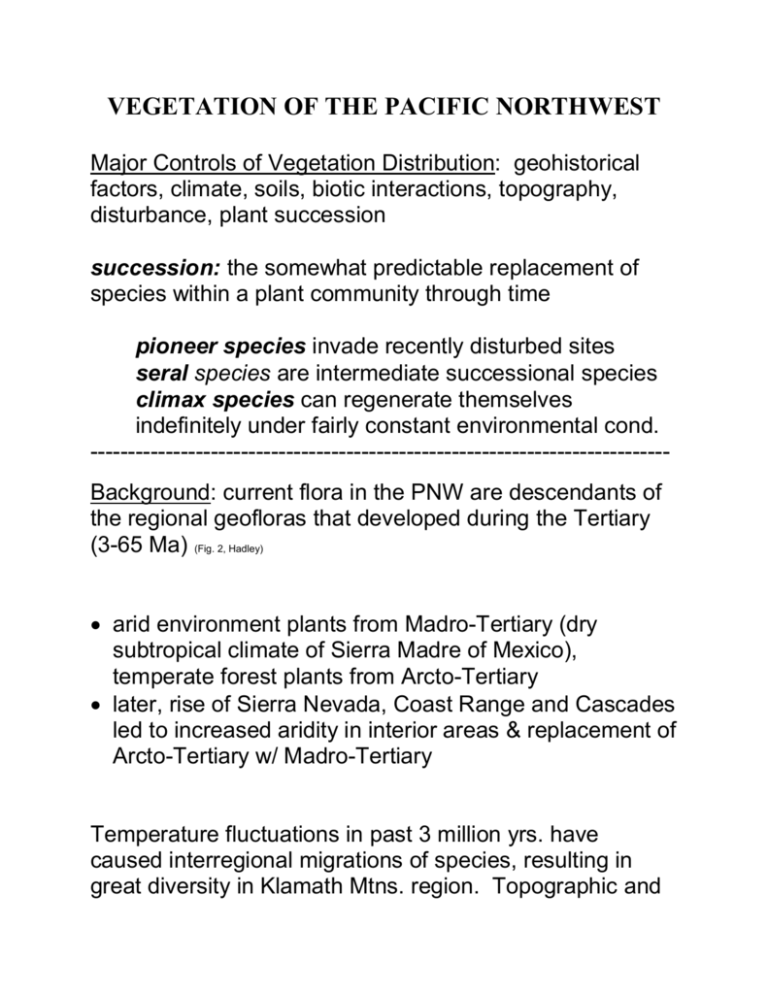vegetation notes - Western Oregon University
advertisement

VEGETATION OF THE PACIFIC NORTHWEST Major Controls of Vegetation Distribution: geohistorical factors, climate, soils, biotic interactions, topography, disturbance, plant succession succession: the somewhat predictable replacement of species within a plant community through time pioneer species invade recently disturbed sites seral species are intermediate successional species climax species can regenerate themselves indefinitely under fairly constant environmental cond. ----------------------------------------------------------------------------Background: current flora in the PNW are descendants of the regional geofloras that developed during the Tertiary (3-65 Ma) (Fig. 2, Hadley) arid environment plants from Madro-Tertiary (dry subtropical climate of Sierra Madre of Mexico), temperate forest plants from Arcto-Tertiary later, rise of Sierra Nevada, Coast Range and Cascades led to increased aridity in interior areas & replacement of Arcto-Tertiary w/ Madro-Tertiary Temperature fluctuations in past 3 million yrs. have caused interregional migrations of species, resulting in great diversity in Klamath Mtns. region. Topographic and edaphic (soil) diversity also contribute to the great species diversity there. REGIONALIZATION OF VEGETATION IN THE PACIFIC NORTHWEST Alpine: stunted vegetation or treeless areas. If below 7,000 feet often function of wind more than temperature. OR-WA-BC coastal forest (low elevations) Sitka Spruce, Red Alder, & Douglas-fir, Shorepine: seral Western Hemlock, Western Redcedar: climax -Coastal Redwoods: size, fire, flood, and insect resistant fire resistance advantage over tanoak, Doug.-fir higher elevations of coastal forest, W. slope Cascades Douglas-fir (seral); Western Hemlock, Western Redcedar, Noble Fir often “climax” species Mountain Hemlock, Subalpine Fir, and Lodgepole Pine at higher elevations Interior Highlands (inc. E. slope Cascades, W. Rockies) Grand Fir and Douglas-fir dominant in more humid or high lands Ponderosa Pine (often climax, fire resistant) and Junipers in lower elevations/drier treed zones Western Larch in recently disturbed environments (shade intolerant) @ 2000-6000 ft. elevation Columbia-Snake Basalt Plateau: drier areas (<10” precip) in sagebrush -marsh grasses and shrubs along sloughs and lakes -wetter zones in bunch grass and flowering plants woodland and forest -woodland of Western Juniper of Cent. OR. -some found in drier areas of sage & bunchgrass Ponderosa Pine and Douglas-fir in areas >15” precip. Basin and Range (S. Central Oregon) -sagebrush and some trees (Pond. pine & Doug.-fir, some spruce & fir in higher elevations) -internally drained basins, many wetlands Klamath Mtns. Zone (including Siskiyous) very diverse: typical: conifers in upper story, broadleaf trees in lower story (Tanoak, Pacific Madrone), oaks chapparal (shrub) in interior Southern Oregon (Rogue & Umpqua Valleys), favored in dry valleys due to leaves, ability to regenerate after fire -manzanita, oaks typical Puget Trough Region: (OR-WA interior western valleys) pre-colonial: area of grassland/savanna under fire regime, now trees mostly Oregon White Oak theoretical climax of Grand Fir or Doug.-fir (drier sites), Big Leaf maple (wetter sites)











